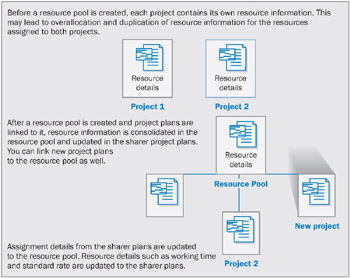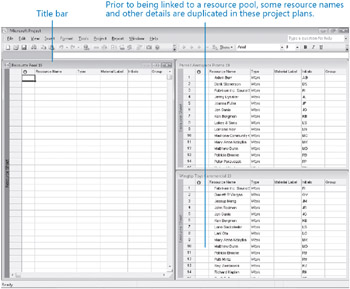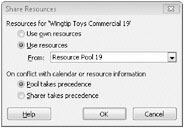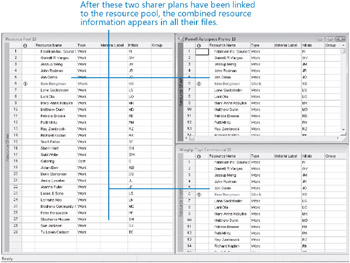Creating a Resource Pool
When managing multiple projects, it is common for work resources (people and equipment) to be assigned to more than one project at a time. It might become difficult to coordinate the work resources’ time among the multiple projects, especially if those projects are managed by different people. For example, a sound engineer in a film studio might have task assignments for a TV commercial, a promotional program, and a documentary film-three projects proceeding simultaneously. In each project, the engineer might be fully allocated or even underallocated. However, if you add together all of her tasks from these projects, you might discover that she has been overallocated, or assigned to work on more tasks than she can handle at one time. When working with cost resources in multiple projects, you might want to see not only the cost per project associated with a cost resource, but the cumulative costs across projects as well. Likewise, when working with material resources in multiple projects, you’d see cumulative consumed material resources in whatever unit of consumption you’ve used.
A resource pool can help you see how resources are utilized across multiple projects. The resource pool is a project plan from which other project plans draw their resource information. It contains information about all resources’ task assignments from all project plans linked to the resource pool. You can change resource information-such as maximum units, cost rates, and nonworking time-in the resource pool, and all linked project plans will use the updated information.
The project plans that are linked to the resource pool are called sharer plans. The following is one way of visualizing a resource pool and sharer plans.

If you manage just one project with resources that are not used in other projects, a resource pool provides you no benefit However, if your organization plans to manage multiple projects, setting up a resource pool enables you to do the following:
-
Enter resource information once, but use it in multiple project plans.
-
View resources’ assignment details from multiple projects in a single location.
-
View assignment costs per resource across multiple projects.
-
View cost resources cumulative costs across multiple projects.
-
View material resources cumulative consumption values across multiple projects.
-
Find resources who are overallocated across multiple projects, even if those resources are underallocated in individual projects.
-
Enter resource information, such as nonworking time, in any of the sharer plans or in the resource pool so that it is available in other sharer plans.
A resource pool is especially beneficial when working with other Project users across a network. In those cases, the resource pool is stored in a central location, such as a network server, and the individual owners of the sharer plans (which might be stored locally or on a network server) share the common resource pool.
In this exercise, you arrange the windows of two project plans that will become sharer plans; this helps you see the effects of creating a resource pool. You then create a project plan that will become a resource pool and link the two sharer plans to it.
Be Sure To start Microsoft Office Project 2007 if it’s not already running.
| Important | If you are running Project Professional, you may need to make a one-time adjustment to use the Computer account and to work offline. This ensures that the practice files you work with in this chapter do not affect your Project Server data. For more information, see “Starting Project Professional” on page 11. |
Open Wingtip Toys Commercial 19a from the \Documents\Microsoft Press\Project 2007 SBS\Chapter 19 Consolidating folder. You can also access the practice files for this book by clicking Start, All Programs, Microsoft Press, Project 2007 Step by Step and then selecting the chapter folder of the file you want to open.
1. On the File menu, click Save As.
The Save As dialog box appears.
2. In the File name box, type Wingtip Toys Commercial 19, and then click Save.
3. On the Standard toolbar, click the Open button.
The Open dialog box appears.
4. Double-click the Parnell Aerospace Promo 19b file.
5. On the File menu, click Save As.
The Save As dialog box appears.
6. In the File name box, type Parnell Aerospace Promo 19, and then click Save.
These two project plans were previously created, and both contain resource information. Next, you will create a new project plan that will become a resource pool.
7. On the Standard toolbar, click the New button. ![]()
Project creates a new project plan, with the Gantt Chart view displayed.
8. On the View menu, click Resource Sheet.
The Resource Sheet view replaces the Gantt Chart view.
9. On the File menu, click Save As.
10. Navigate to the Documents\Microsoft Press\Project 2007 SBS\ Chapter 19 Consolidating folder.
11. In the File name box, type Resource Pool 19, and then click Save.
| Tip | You can name a resource pool with any name you want, but it is a good idea to indicate that it is a resource pool in the file name. |
12. On the Window menu, click Arrange All.
Project arranges the three project plan windows within the Project window.

| Tip | You do not need to arrange the project windows in this way to create a resource pool, but it is helpful to see the results as they occur in this chapter. |
Looking at the resource names in the two project plans (Parnell Aerospace Promo 19 and Wingtip Toys Commercial 19), you can see that several of the same resources appear in both project plans. These include Fabrikam Inc. Sound Studio, Jon Ganio, Ken Bergman, Catering (a cost resource), and others. None of these resources are overallocated in either project.
13. Click the title bar of the Wingtip Toys Commercial 19 window.
14. On the Tools menu, point to Resource Sharing, and click Share Resources.
The Share Resources dialog box appears.
15. Under Resources for ‘Wingtip Toys Commercial 19’, select the Use resources option.
The Use Resources From list contains the open project plans that can be used as a resource pool.
16. On the From list, make sure that Resource Pool 19 is selected in the drop-down list.

17. Click OK to close the Share Resources dialog box.
You see the resource information from the Wingtip Toys Commercial 19 project plan appear in the Resource Pool 19 plan. Next, you will set up the Parnell Aerospace Promo 19 project plan as a sharer plan with the same resource pool.
18. Click the title bar of the Parnell Aerospace Promo 19 window.
19. On the Tools menu, point to Resource Sharing, and then click Share Resources.
20. Under Resources for ‘Parnell Aerospace Promo 19’, click the Use resources option.
21. On the From list, make sure that Resource Pool 19 is selected.
Resource Pool 19 is selected by default. The Wingtip Toys Commercial 19 project plan is already a sharer plan, and Project won’t allow a sharer plan to be a resource pool for another project plan.
22. Under On conflict with calendar or resource information, make sure that the Pool takes precedence option is selected.
Selecting this option causes Project to use resource information (such as cost rates) in the resource pool rather than in the sharer plan should it find any differences between the two project plans.
23. Click OK to close the Share Resources dialog box.
You see the resource information from the Wingtip Toys Commercial 19 project plan appear in the resource pool.

The resource pool contains the resource information from both sharer plans. Project will consolidate resource information from the sharer plans based on the name of the resource. Jon Ganio, for example, is listed only once in the resource pool, no matter how many sharer plans list him as a resource.
| Important | Project cannot match variations of a resource’s name-for example, Jon Ganio from one sharer plan and J.Ganio from another. For this reason, it is a good idea to develop a convention for naming resources in your organization, and then stick with it. |
Again, you do not have to arrange the project windows as you did in this exercise to link the sharer plans to the resource pool. However, it is helpful in this chapter to see the results as they occur.
| Tip | If you decide that you do not want to use a resource pool with a project plan, you can break the link. On the Tools menu, point to Resource Sharing, and click Share Resources. Under Resources For <Current Project Name>, select the Use Own Resources option. |
Any project plan, with or without tasks, can serve as a resource pool. However, it is a good idea to designate a project plan that does not contain tasks as the resource pool. This is done because any project with tasks will almost certainly conclude at some point, and you might not want assignments for those tasks (with their associated costs and other details) to be included indefinitely in the resource pool.
Moreover, a dedicated resource pool without tasks can enable people, such as line managers or resource managers, to maintain some information about their resources, such as nonworking time, in the resource pool. These people might not have a role in project management, and they will not need to deal with task-specific details in the resource pool.
EAN: 2147483647
Pages: 247